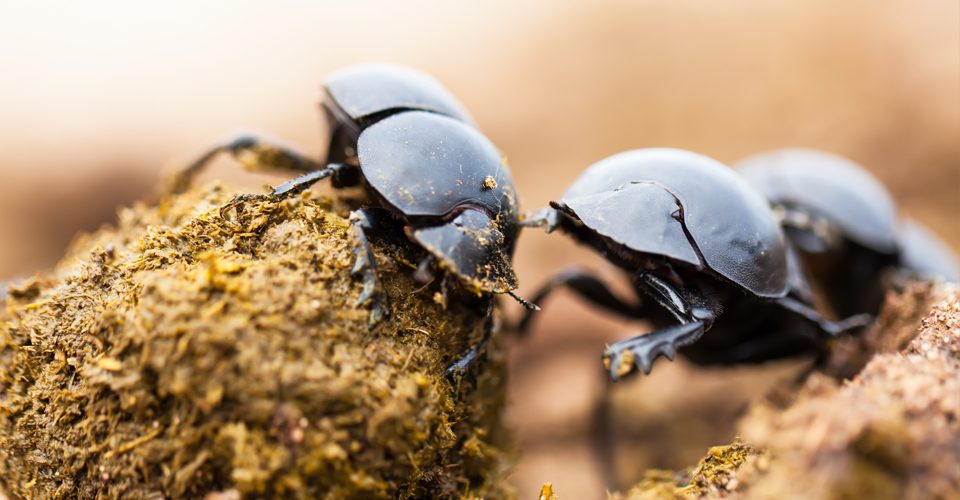This is an exclusive excerpt of the Preface to The Origin of Feces: What Excrement Tells Us About Evolution, Ecology, and a Sustainable Society, ECW Press, Toronto, May 2013. Read “The Other Dark Matter” in the Lifecycles issue. Buy the issue today!
TO THE DISMAY OF THE OTHERS on our walkabout [in Selous Game Reserve], I had corralled the guides into helping me find animal scat. What kind of an idiot comes to Africa to look at shit? Well, I’m a veterinarian, so maybe it fits.
A small white pile of feces, away from a lake-sized widening in the Rufiji River, was probably hyena. The white indicated a carnivore, the crushed bones of its prey bleaching in the hot sun. A similar whitening (and hence carnivore) pile closer to the lake was probably from a crocodile. Small pellets in a heap were male impala marking territory, as well as providing nitrogen and phosphorus for plants. Female impala scat were a more scattered whisper across the landscape, and less a megaphone to announce ownership. Buffalo dung pies were flat, circular pats like domesticated cow dung, but firmer. Zebras’ feces, as we might have expected, were more horse-like, kidney-shaped and darker than buffalo dung. Hippo dung on the path was like that of an elephant — a big cylindrical sausage — but wetter and with less fiber. The increased water content is associated with a lower concentration of nutrients, meaning it is less attractive as a food source for other species than elephant dung. The lower fiber concentration also means hippo dung is less useful for making paper than elephant dung. Hippos, who cannot see well, use a tactic that would have saved Hansel and Gretel, with their dainty bread crumbs, considerable grief. They mark the path to and from the river with their dung when they go on nighttime food foraging and pillaging expeditions, so they can use it to find their way back from the riverbank. Hippos are thus moving nutrients from the water to the land and, when they defecate in the water (which they also do), back to aquatic systems.
Each of the scats I saw along the trail in Tanzania told me something about the animals and their ecological places in this landscape, and the ways in which they have physically changed the landscape (eating plants, stomping paths, transferring seeds). Nevertheless, looking at animal scat was still vaguely unsatisfying. What I really wanted to see, much to the dismay of my fellow safari-ists, most of whom were honeymooners, were the queens of the wilderness — dung beetles. I think I was, at first, somewhat amused by the notion that there are animals that literally eat shit. What did they look like? How did they do it?
I was heading back to my tent after the walk when Eduard, one of our two guides, came running after me. He and Mpato had found some dung beetles near the camp, hard at work! Strangely, as Eduard told me about this amazing find, the other tourists disappeared.
“You go,” said my wife. “I have some important reading to do.”
“Their loss,” I thought as I followed Eduard a hundred meters down the path to where Mpato was guarding a large pile of elephant dung with his hunting rifle. I crouched down next to him, the sun beating down on my head, the sweat trickling down the middle of my back.
If I was disappointed with what I saw, I did not show it, although I had secretly wished for a re-creation of the scene described by two researchers in 1974; they had observed 16,000 dung beetles attack one 1.5-kilogram pile of elephant dung and eat, bury, and roll away the whole pile within two hours. I had to remind myself that seeing even two thumb-sized black beetles scuttling around the dung-pile was more than I should have expected this time of year. In the dry season, most dung beetles in the area were already hunkered underground in front of their television sets, watching reruns of Bushland Idle.
One of the two beetles was industriously pulling down chunks from the heap of dung and tamping them down to form a ball. Nearby, another beetle was busy burying his ball. The sandy earth shifted up and down with his subterranean digging movements. We squatted in the hot sun, watching the manic, obsessive beetles at work. If Mpato and Eduard were puzzled at my interest, they were too polite to show it.
Just when we thought he seemed done, when the walnut-sized sphere of dung — twice his size — looked perfect to me, the beetle would pull down another piece and tap it into some imperceptible imperfection. Finally he started rolling the ball away from the dung pile, uphill, over twigs, his hind end up against the ball, front end down on the ground. He strained and tumbled over a small branch and rolled into a little gully, still clinging to his large ball. Then he clambered up, had a look around at the lay of the land, and started pushing again. Periodically, he dug down into the earth or under the leaf litter, then came back up and resumed pushing. He pushed and tumbled his way some eight meters from the dung pile, uphill almost all the way, until he finally started digging seriously, his ball sinking into the leaf litter, heaving once or twice, and then sinking from view.
The other beetle, nearest to the dung pile, made another, smaller, ball, dug a hole, pushed in the ball, and then came back out and pulled in more dung. Both beetles were probably males, who are stronger than females, and who usually do the rolling. Sometimes, males and females will roll the ball together, bury it, dig a tunnel nearby, have sex, and then insert the fertilized eggs into the ball. If another male comes along that wants sex with the female, the two males lock horns and try to push each other out of the tunnel. According to some researchers, these battles for sex have resulted in some beetles that can pull more than 1,000 times their own weight — a person, say, pulling six double-decker buses full of people. It would not be the first time that a male has gone to the gym to improve his chances of finding a sexual partner.
In the case of the beetles I was watching, I could see no females around. Perhaps they had already bred. Or perhaps they were single males, unlucky in love, tucking away a bit of nourishment for the rest of the dry season, in which case there was some poignancy to the scene I was observing.
Whatever their personal stories, it occurred to me that what I was watching was surely more than a curiosity. A huge amount of energy was being expended by these animals to build and bury these large nutri-balls of manure. While this energy use makes sense for them as individuals in that it enables the survival of their young, it also makes sense in much larger terms. For what nourishes their young also nourishes the landscape, which provides food for the elephants, who provide the shit that allows the dung beetle babies — as well as many other species — to live through the dry season. A 2008 review of the ecological literature on dung beetles by the Dung Beetle Ecology Working Group of ScarabNet summarized contributions of various dung beetles to cycling of nutrients, enhancing plant growth, controlling parasites, and dispersing seeds. The unpaid and unsung work of these beetles in parasite control, pasture improvement, and reduction in greenhouse gases has contributed hundreds of millions of dollars to global agriculture.
There are dung beetles on every continent except Antarctica. Many are adapted to work not just in particular landscapes, but are also fastidious about the kinds of dung they eat. The dung beetles of Australia, for instance, accustomed to marsupial dung, wanted nothing to do with cow pats. For almost 200 years after European settlement, as the geographic extent and number of cattle increased, the problems associated with dung flies and general stinky unpleasantness increased. In the 1970s, in an experiment considerably more successful than the ill-advised importation of cane toads to kill cane pests, some twenty species of African dung beetle were selected and imported. These brought the cattle manure situation under control and helped improve soil and pasture quality. Unfortunately, the widespread use of drugs to treat insect pests on cattle, a process which also kills dung beetles, may now be reversing some of those gains.
Like all of us, dung beetles can be classified by their physical characteristics, their genetics, and their behavior. The ones I observed in Tanzania were rollers: they wrap a ball of feces around their eggs and then bury them. When the larvae hatch, they eat the dung around them, which must mean that the dung itself is rich in energy and nutrients — energy and nutrients that would otherwise leak away into the environment. Not all dung balls are as small and malleable as the ones I saw. The balls created by some Indian scarabs have been mistaken for old stone cannonballs, because the clay with which the beetles covered them had hardened. Tunnelers bury the feces, and dwellers, the laziest of the bunch, just live in it. Some species hang around watching a neighbor roll up a large ball, and then, when he skitters off to get more dung, they steal it!
While there are ongoing debates among coleopterists (people who study beetles and their habits) over details of beetle evolution, what is not in doubt is that excrement-eating beetles have been around for a long, long time. Early scarab beetles(Scarabaeoidea), from which modern dung beetles evolved, appear to have been around for more than 150 million years, and “true” dung beetles (the ones that actually eat dung), about forty million years. Evidence from fossilized dung pieces, called coprolites, suggests that dung beetles developed commensal relationships with dinosaurs in the Mesozoic period, that is, more than sixty-five million years ago, when the continents were slowly creaking and groaning on their rebellious, separate ways, budding off from mother-father Pangaea and carrying with them a variety of species to start new lives elsewhere on the globe. If we are serious about staying around on the planet for a long time and maintaining a meaningful, if challenging, lifestyle, we could do worse than to consult the dung beetles.
Many scientists love to get close, really close, to nature, to focus on a few small things to the exclusion of all else. So, if you search the literature on dung beetles, you will find references to anywhere from 5,000 to more than 7,000 species, divided into twelve tribes, with a couple hundred new species being described every year. There are about 100 species of dung beetle devoted to elephant dung alone. Part of the problem of keeping count is that the nomenclature has been unclear, with some writers slipping back and forth between “dung beetles” and “scarabs.”
Although all scarabs are great recyclers, not all scarabs are dung beetles. The Scarabaeoidea are a superfamily, including within it families whose names include such luminaries as sand-loving, enigmatic, earth-boring, rain, and bumble-bee beetles. They include fungivores (which eat fungi), herbivores (eat plants), necrophages (eat dead things), carnivores (eat other animals), saprophages (eat any kind of decaying organic matter), and — the ones that interest us in this book — the coprophages (eat shit). Species in the subfamily Scarabaeinae are sometimes referred to as the “true” dung beetles, since most of them feed almost exclusively on feces. The taxonomic boundaries of their families, subfamilies, and tribes may be unclear, but all can claim royal heritage. Scarabs were revered, and rightly so, by the ancient Egyptians — another case, and there are many, where traditional religious practices helped preserve important ecological functions.
To the ancient Egyptians, rather than representing filth and feces, the scarab suggested death and rebirth, renewal and resurrection. Like the god Khepri, who created himself from nothing, rolled the sun through the darkness, and, voilà, presented it new each morning, the scarab rolled its sphere to the underworld and, fifteen to eighteen weeks later, was reborn. Hence, the name and picture used to depict the scarab was “to come into existence,” and hence the celebration of the scarab in precious metals and stones, bones and ivory, in funeral rites of the region and in “mummy” adventure B-movies.
While most tourists in Africa pay attention to the so-called charismatic megafauna such as impala and elephants, few are attentive to the much smaller creatures that help create the landscapes in which those larger animals live, and which enable them to survive. Early in human evolution, it made sense to pay attention to animals you could eat, or that might be a threat to you. In the twenty-first century, it is the loss of the animals we don’t see, and for which we don’t see an immediate use — dung beetles for instance — that may pose the biggest threat to us. Dung beetle safaris should be the next great opportunity for ecotourism.
David Waltner-Toews is a professor emeritus of Population Medicine at the University of Guelph, and founding president of Veterinarians Without Borders – Canada, and the Network for Ecosystem Sustainability and Health. He is also the author of more than 100 scholarly papers and 21 books of non-fiction, fiction and poetry.













